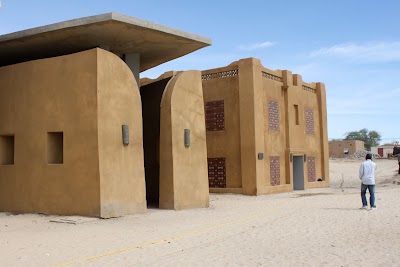Fort of Gao (حصن غاو)
Overview
Discovering the Fort of Gao: A Historical Gem in Mali
Nestled within the Taoudénit Region of Mali, the Fort of Gao stands as a powerful testament to the rich history and cultural legacy of West Africa. This ancient fortification, dating back several centuries, offers a unique glimpse into the region's military and architectural prowess. Situated on the edge of the Sahara Desert, the fort invites travelers to delve into the historical depths of Mali and its significance in the broader context of African history.
Historically, the Fort of Gao has served as a crucial stronghold, playing a pivotal role in defending and administering the region. Once the heart of the Songhai Empire—one of Africa's greatest pre-colonial civilizations—Gao reached its zenith between the 15th and 16th centuries. The mighty fort served as a strategic hub, protecting inhabitants from invaders while acting as a landmark for traders navigating the Trans-Saharan trade routes. Its walls have silently witnessed the ebb and flow of various empires and countless historical events.
Architectural Marvels
The architectural design of the Fort of Gao embodies traditional Sahelian styles, interwoven with influences from various cultures that have touched this land over the centuries. Constructed primarily from mudbrick, the fort's thick, towering walls are an awe-inspiring example of ancient engineering. Remarkably, despite the harsh climatic conditions of the Sahara, the fortification has largely withstood the test of time. Visitors are often captivated by the detailed engravings and unique design elements that adorn its walls, offering a visual narrative of the region's rich cultural tapestry against the austere desert backdrop.
One of the most fascinating aspects of the Fort of Gao is its strategic design. The fort features well-planned lookout points and battlements, essential for surveillance and defense. As you explore these features, you’ll gain a palpable sense of the challenges and strategies involved in protecting this vital outpost. Hidden passages and rooms, once used for storage and secret meetings, add an air of mystery and intrigue, inviting visitors to imagine the bustling activity during the fort's heyday.
A Cultural Epicenter
The significance of the Fort of Gao extends far beyond its military uses. It was also a thriving center for trade and culture, fostering interactions among diverse groups. Gao was a melting pot where merchants, scholars, and travelers from across Africa and the Middle East converged, facilitating the exchange of goods, ideas, and traditions. The fort, as a crucial part of this urban fabric, symbolizes the confluence of commerce, culture, and conflict that has shaped Mali's history.
For modern tourists, visiting the Fort of Gao offers an immersive experience that goes beyond mere historical exploration. Guided tours are often available, providing in-depth insights into the fort's history, architecture, and significance. Local guides, rich in knowledge about the area's past and present, paint vivid pictures of historical events and everyday life within the fort's walls. The fort's location also allows for breathtaking views of the surrounding desert, especially during sunrise and sunset, when the shifting sands glow in golden and crimson hues.
Engaging with Local Culture
Another compelling draw for tourists is the opportunity to engage with local culture and communities. Gao and its surrounding areas are home to a vibrant mix of ethnic groups, each with their unique traditions and crafts. Visitors can experience the warm hospitality of the locals, sample traditional Malian cuisine, and purchase handmade crafts that reflect the region's rich cultural heritage. This cultural immersion transforms your visit from a mere sightseeing trip into a meaningful encounter with Mali's living history.
In conclusion, the Fort of Gao in the Taoudénit Region of Mali is a captivating destination for anyone interested in history, architecture, and culture. Its storied past, combined with impressive architectural features and the vibrant culture of the surrounding region, makes it an essential stop for any traveler exploring West Africa. Whether you're a history buff, an adventurer, or someone looking to connect with local traditions, the Fort of Gao offers a richly rewarding experience that will remain etched in your memory long after you’ve left its ancient walls.





